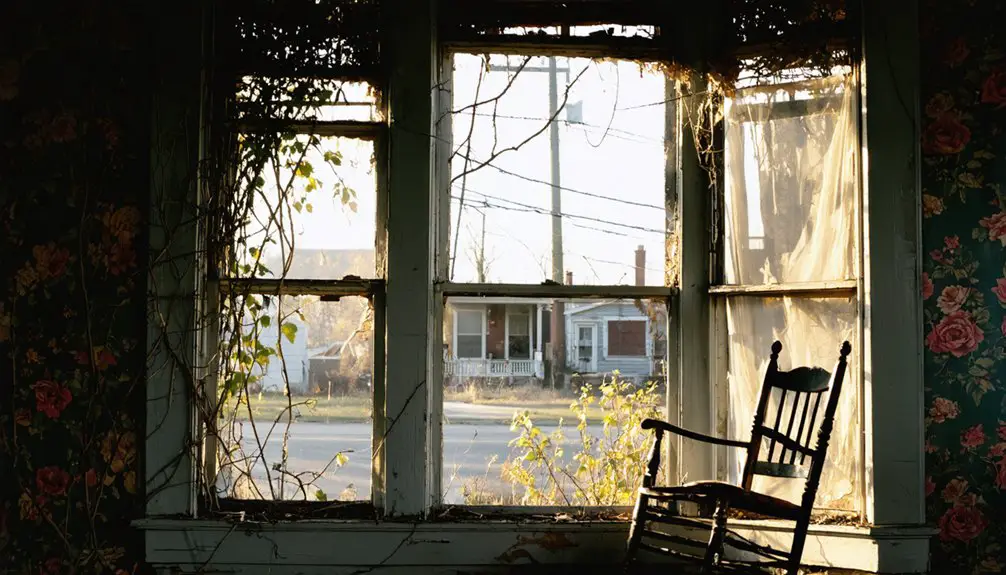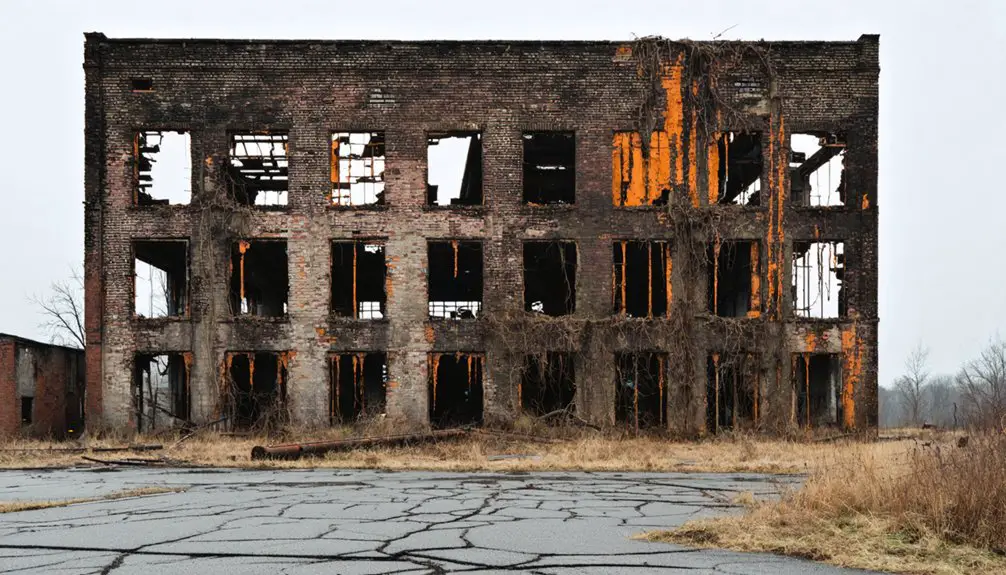You’ll find the ghost town remnants of Clairton’s Lincoln Way neighborhood just south of Pittsburgh, where a once-thriving steel community of 20,000 has dwindled to just over 6,000 residents. The abandoned streets tell stories of close-knit families who lived in the shadow of Carnegie Illinois Steel mill’s smokestacks until industrial decline, toxic pollution, and economic hardship forced them out. Beyond the boarded windows and collapsed floors lies a complex tale of resilience, environmental devastation, and haunting local legends.
Key Takeaways
- Clairton’s population drastically declined from 20,000 in the 1950s to 6,181 today, leaving numerous abandoned buildings and neighborhoods.
- Lincoln Way, a former residential area, became a ghost town due to industrial pollution and economic decline before demolition in 2017-2018.
- The abandoned streets feature boarded windows, collapsed floors, and personal belongings left behind by former residents.
- Local folklore includes supernatural horror stories, creature sightings, and unexplained phenomena in the deserted areas.
- Environmental contamination from Clairton Coke Works, including toxic soil and air pollution, contributed to neighborhood abandonment.
The Rise and Fall of Lincoln Way
While steel towns across America faced industrial decline, few places embody the stark transformation quite like Lincoln Way in Clairton, Pennsylvania.
You would’ve found a vibrant hub of community resilience here, where close-knit Black families built their lives around the Carnegie Illinois Steel mill. The cultural heritage thrived through local churches, businesses, and social gatherings, creating a strong sense of identity in this 16-home cul-de-sac. Residents maintained gardens and livestock to ensure their community’s self-sufficiency. The neighborhood struggled with constant exposure to coke production pollution from the nearby mill.
But you won’t find that liveliness today. The neighborhood’s decline wasn’t sudden – it crept in as the steel industry faded, tax delinquencies mounted, and maintenance costs overwhelmed aging residents.
Life in a Steel Mill Town
When Crucible Steel acquired land along the Monongahela River in 1900, you’d never guess that an empty field would transform into a bustling industrial city within two decades. Today, with a mere 6,181 residents, the city’s population has dramatically declined from its peak of nearly 20,000 in the 1950s.
Life in Clairton’s steelworker communities revolved entirely around the mill’s demanding rhythm, where you’d work alongside neighbors in one of America’s largest coke production facilities.
Your daily life in this industrial heritage town would include:
- Processing over 12,500 tons of coal daily at the massive Clairton Coke Works
- Living in neighborhoods strategically built near the mill, where smoke stacks defined the skyline
- Participating in mill-sponsored events, sports teams, and social clubs that brought workers together
The steel mill wasn’t just your workplace – it shaped your community’s identity, from the schools your children attended to the churches where you worshipped. Workers faced serious health risks, with those working at coke oven tops experiencing up to 10 times higher cancer rates.
Environmental Legacy of Clairton Works
If you’d lived in Clairton during its peak steel years, you’d have witnessed thick smog that turned white shirts gray and left a metallic taste in your mouth.
Today’s residents still face the consequences of decades of industrial pollution, with Clairton Coke Works remaining Allegheny County’s worst air polluter and contributing to high cancer rates among locals.
The facility’s outdated equipment from the 1950s continues to malfunction and break down, creating ongoing air quality problems for the community. The plant’s aging infrastructure and repeated violations have left a toxic legacy in both the air and soil, forcing many families to question whether they can safely raise their children in a town where environmental fines seem to pile up faster than meaningful changes. A recent $42 million settlement aims to address thousands of air pollution violations and upgrade critical pollution control systems at the facility.
Lasting Health Impacts Today
Despite decades of regulatory efforts, the environmental legacy of Clairton Works continues to inflict severe health consequences on surrounding communities.
You’ll find stark health disparities throughout the Mon Valley, where chronic illnesses have become an unwanted inheritance passed down through generations.
Living near the facility means confronting these sobering realities:
- You’re exposed to 232 tons of hazardous air pollutants annually, including known carcinogens like benzene and chromium.
- Your risk of developing asthma and respiratory illnesses spikes dramatically during pollution events.
- Your family faces increased cancer risks from long-term exposure to toxic chemicals.
The lack of real-time monitoring leaves you vulnerable, while aging infrastructure and frequent violations mean you can’t escape the constant threat of pollution spikes and accidents that plague your community.
Local students suffer from 22.4% asthma rates, drastically impacting school attendance and childhood development.
The recent U.S. Steel explosion has only intensified fears about safety and environmental risks in the area.
Air Quality Through Decades
Throughout Clairton’s industrial history, you’ll find a stark pattern of environmental degradation stemming from the Clairton Coke Works‘ aging infrastructure.
You’re looking at equipment dating back to the 1950s that’s still operating today, leading to constant malfunctions and dangerous fires like the devastating 2018 Christmas Eve blaze that crippled pollution controls. The recent deadly explosion further highlighted the risks of aging industrial facilities.
The air quality impact has been relentless. You’ll notice that Pittsburgh ranks eighth worst nationally for air pollution, with Clairton bearing much of the blame.
When you drive through town, you can’t miss the sulfur dioxide and other toxic emissions that plague local neighborhoods. A recent study revealed that 22% of local children suffer from asthma, triple the national average.
The community’s activism has sparked multiple legal battles, resulting in over $11 million in fines since 2020, but the aging plant continues to cast its shadow over this once-thriving steel town.
Toxic Soil Contamination Issues
While Clairton’s air pollution makes headlines, you’ll find an equally troubling environmental crisis lurking beneath your feet. The toxic legacy of Clairton Coke Works has left its mark in the soil, with contamination sources ranging from decades of coking operations to equipment failures that continue today.
You’re living with the consequences of three major soil issues:
- Toxic metals like lead, arsenic, and mercury that won’t break down
- Sulfur compounds that make soil more acidic, allowing these metals to spread
- PAHs and organic pollutants from coke production that persist in the ground
Despite $2.6 million in recent fines, you won’t find much soil remediation happening. The contamination remains, threatening future generations as these toxins stay locked in the earth, a silent reminder of industrial negligence.
The Final Days of a Neighborhood

As the once-vibrant steel town of Clairton entered the 21st century, its neighborhoods began showing unmistakable signs of terminal decline.
You’ll find over 700 abandoned properties dotting the landscape, their empty windows staring out at crumbling streets where children once played. The median household income has plummeted to just $36,000, while nearly a quarter of your neighbors live in poverty.
Despite this neighborhood neglect, you’ll witness remarkable community resilience as residents fight for their hometown’s survival.
Local activism groups rally against toxic pollution from the coke works, even as the population dwindles to 6,100 – a shadow of its 1950s peak.
In these final days, you’ll see both despair and determination, as longtime residents struggle to maintain their community amid decaying infrastructure and vanishing services.
Urban Legends and Local Folklore
Deep within Clairton’s abandoned streets, particularly along Lincoln Way, you’ll find a rich tapestry of urban legends that blend environmental fears with supernatural horror.
Local folklore speaks of creature sightings – a mysterious beast unlike any known animal that terrorized the neighborhood before its abandonment.
The haunted folklore of Lincoln Way centers around three distinct elements:
- Reports of pets found mutilated near the surrounding forest
- Gardens destroyed by massive, unidentifiable paw prints
- Unexplained thumping and scratching sounds on homes at night
While residents largely dismissed these tales as myths, the eerie atmosphere of decaying homes and overgrown yards continues to fuel supernatural speculation.
The truth behind Lincoln Way’s abandonment lies more in economic decline and environmental concerns than any paranormal activity.
Documenting the Decay

Beyond the supernatural tales, Lincoln Way’s stark reality tells a more haunting story through its physical deterioration.
As an urban exploration destination, you’ll find extensive documentation of its descent – from boarded windows to collapsed floors and debris-strewn porches. Historical preservation efforts have struggled here, as fire damage from arson has erased many physical traces of the neighborhood’s past.
Walking these streets today, you’ll notice small sinkholes appearing between abandoned lots, while personal belongings left behind by elderly residents and widows paint a poignant picture of lives interrupted.
Time-worn trinkets and forgotten mementos scatter through empty homes, telling silent stories of lives suddenly left behind.
Though urban explorers have increasingly documented the decay through photos and reports, the neighborhood’s ruins have largely vanished following demolition in 2017-2018, leaving only archived images to tell Lincoln Way’s story.
Visions for Tomorrow: Redevelopment Plans
While Lincoln Way’s buildings may have crumbled, Clairton’s ambitious redevelopment plans aim to breathe new life into the region.
You’ll find sustainable infrastructure and community revitalization at the heart of these transformation efforts, with $19.85 million already flowing into Route 51’s reconstruction.
The city’s vision includes three major initiatives:
- Compact infill development integrated with upgraded transportation and utilities
- Housing expansion through D.R. Horton’s 530-home Enclave project and rehabilitation programs
- Environmental restoration focusing on green spaces and solar energy installations
You’re witnessing a pivotal moment as Clairton shifts toward a greener future, balancing industrial heritage with modern needs.
The thorough plan’s “fix it first” approach guarantees you’ll see immediate improvements while laying groundwork for long-term growth.
Frequently Asked Questions
What Happened to the Personal Belongings Left Behind in Abandoned Homes?
You’ll find forgotten treasures were stolen, destroyed by fires, or crushed under collapsing homes. Those haunting memories – beds still made, clothes untouched – were lost to vandals and nature’s decay.
Did Any Former Lincoln Way Residents Move to Other Parts of Clairton?
Yes, you’ll find former residents resettled in other Clairton neighborhoods, maintaining their community ties. Though exact numbers aren’t documented, interviews and anecdotal evidence show many chose to stay within city limits.
What Was the Average Home Value on Lincoln Way Before Abandonment?
Money talks, but you won’t believe how little Lincoln Way homes were worth before abandonment. Despite their historical significance, market fluctuations drove average values down to around $1,000-$20,000 per property.
Were There Any Successful Businesses Operating on Lincoln Way?
You’ll find Lincoln Way had modest successful establishments like doctors’ offices, midwives, and a community bathhouse. Small shops served locals, while churches like Gethsemane became essential community anchors.
How Many Children Lived on Lincoln Way During Its Peak Years?
While exact historical demographics aren’t documented, you’re looking at roughly 40-60 children during Lincoln Way’s peak years, based on typical child population patterns in mid-century steel town households.
References
- https://middleageschmo.wordpress.com/2016/02/05/the-ghost-street-of-clairton-pennsylvania-usa/
- https://militarybruce.com/the-lost-neighbourhood-of-lincoln-way/
- https://www.abandonedamerica.us/lincoln-way
- https://www.youtube.com/watch?v=hUlkdTUf8jk
- https://architecturalafterlife.wordpress.com/2015/01/27/the-eerie-abandoned-neighborhood-of-lincoln-way/comment-page-1/
- https://groundedpgh.org/residents-remember-lincoln-way/
- https://www.youtube.com/watch?v=ePUK_GOM4ZE
- https://pittsburghorbit.com/2017/02/22/into-the-forgotten-clairtons-ghost-neighborhood/
- https://en.wikipedia.org/wiki/Clairton_Coke_Works
- https://en.wikipedia.org/wiki/Clairton



